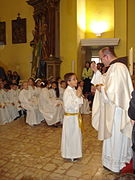제1차 성찬식
First Communion첫 번째 성찬식은 일부 기독교 전통에서 교회의 한 사람이 처음으로 [1]성찬을 받는 의식이다.그것은 가톨릭,[2][3] 루터 교회, 성공회 등 라틴 교회 전통의 많은 부분에서 가장 흔하다.세례나 확인과는 별개로 첫 번째 성찬식을 축하하는 교회에서, 그것은 보통 7세에서 13세 사이에 일어나며, 종종 통과의례로 작용한다.다른 교파에서는 일반적으로 첫 번째 성찬식은 청소년기나 성년기의 어느 시점에 일어나는 확인식의 접수를 따르는 반면, 동방 정교회와 동양 정교회는 성찬식과 함께 유아기에 성찬식의 성찬을 받는다.
특성.

가톨릭 신자들은 성찬식이 가톨릭 신학과 실천에서 중심적인 역할을 하기 때문에 이 행사가 매우 중요하다고 믿는다.
첫 번째 성찬식은 동방 정교회, 동양 정교회, 아시리아 동방 교회에서 기념되지 않는데, 그들이 유아 성찬식을 행하기 때문이다.일부 성공회 신자들은 유아 성찬을 허용하는 반면, 다른 성공회 신자들은 대개 10대 [dubious ]동안 미리 확인 접수를 요구한다.
이 의식의 기념식은 많은 개신교 교회에서 일반적으로 덜 정교하다.가톨릭 신자들과 몇몇 개신교 신자들은 그리스도가 성체성체 안에 진정으로 존재한다고 믿는다; 로마 가톨릭 신자들은 이것이 성체성체를 통해서라고 믿고, 루터교는 성체성체성체성체성체성체성체성체성체성체성체성체성체성체성체성체성체성체성체성체성체성체성체성체성체성체성체성체성체성체성체성체성체성체성체성체성체성체성체성체성체성체성체성체성체성체성체성체성체성체성체성체성체성체성체성체에센스.[4][5][6] 다른 교파들은 성찬식이 예수의 마지막 만찬을 기억하는 상징적인 식사이자 수단과 같은 다양한 이해들을 가지고 있다.
전통
첫 성찬식은 가톨릭 가족과 개인들에게 중요한 전통이다.라틴 교회 가톨릭 신자들에게, 성찬식은 보통 세례를 받은 후에, 그리고 사람이 이성의 나이에 도달했을 때에만 일어난다.첫 번째 고백(고행의 첫 번째 성찬식)은 성찬식에 앞서야 한다.성인으로 가톨릭 교회에 입교하는 사람들은 첫 번째 성찬식 직전에 확인된다.1910년, 교황 비오 10세는 엘렌 오르간의 사례로 인해 첫 성찬식을 받는 나이를 7세로 바꾼 쿰 싱귤러리 칙령을 발표했다.이전에는 현지 표준이 10년,[7] 12년, 심지어 14년이었다.비잔틴 가톨릭 신자들은 유아 세례와 같은 날에 세례, 확인, 성찬식의 성사를 기념합니다.
제1차 성찬식을 둘러싼 축하 전통은 보통 이 행사를 축하하기 위한 큰 가족 모임과 파티를 포함한다.첫 번째 통신원은 특별한 옷을 입는다.그 옷은 종종 순수함을 상징하기 위해 흰색이지만, 모든 문화권에서 그렇지는 않다.종종, 소녀는 화려한 드레스와 베일을 꽃이나 다른 머리 장식품에 붙인다.다른 지역 사회에서는, 소녀들이 보통 자매나 어머니로부터 물려받은 드레스를 입거나 심지어 단순히 베일이나 화환과 함께 교복을 입는다.소년들은 정장과 넥타이, 턱시도, 그들의 일요일 베스트 또는 국민 드레스를 입을 수 있으며, 왼쪽 팔에 수놓은 완장을 차고 가끔 흰 장갑을 낀다.
많은 라틴 아메리카 국가들에서, 소년들은 금색 땋은 아이길레트가 달린 군복 스타일의 정장을 입는다.스위스에서는 남자아이들과 여자아이들 모두 갈색 나무 십자가가 있는 평범한 흰색 예복을 입는다.스페인, 독일, 룩셈부르크, 오스트리아, 그리고 괌에서는 소녀들이 어린 신부 복장을 하고 있지만, 이것은 최근 일부 albs로 대체되었다.
스코틀랜드에서, 소년들은 전통적으로 킬트와 킬트에 동반되는 다른 스코틀랜드 전통 드레스를 입는다.필리핀에서는 남자아이들은 바롱 타갈로그나 반정장 양복을 입고, 여자아이들은 평범한 흰색 드레스와 때로는 베일을 착용하며, 첫 번째 성찬식은 종종 순결한 수정절이나 그 즈음에 열린다.
성경, 어린이 또는 청소년의 매일의 기도서, 묵주, 기도서, 종교상, 아이콘, 그리고 성스러운 카드와 같은 종교적인 성질의 선물이 주로 주어진다.금전적인 선물도 [8]흔하다.
많은 가정에서는 이 행사를 기념하기 위해 솔직한 스냅사진 외에 공식적인 전문 사진을 찍습니다.일부 교회에서는 결혼식 후에 전문 사진작가를 주선한다.
갤러리
「 」를 참조해 주세요.
레퍼런스
- ^ Jethro Higgins (2018), Holy Communion: What is the Eucharist?, Oregon Catholic Press
- ^ Smith, Peter Jesserer (21 March 2020). "Ordinariate Becomes 14th U.S. 'Restored Order' Diocese". National Catholic Register. Retrieved 22 March 2020.
With the recent pastoral letter “Come, Holy Ghost,” Bishop Steven Lopes revealed the Ordinariate of the Chair of St. Peter would now become the 14th Latin-Rite diocese to make the reception of Holy Eucharist which normally follows Confirmation, something commonly called “restored order” of the sacraments, with a focus on involving the child’s family in sacramental preparation. ... The following U.S. Latin-Rite dioceses have currently embraced a restored order for the Sacraments of Initiation: Saginaw, Michigan (1995); Great Falls-Billings, Montana (1996); Portland, Maine (1997); Spokane, Washington (1998); Fargo, North Dakota (2002); Gaylord, Michigan (2003); Tyler, Texas (2005); Phoenix, Arizona (2005); Honolulu, Hawaii (2015); Denver, Colorado (2015); Manchester, New Hampshire (2017); Springfield, Illinois (2017); Gallup, New Mexico (2019); and the Ordinariate of the Chair of St. Peter (2020).
- ^ "At what age do congregation members receive communion?" (PDF). Evangelical Lutheran Church in America. 2013. p. 1. Retrieved 15 March 2020.
Some congregations follow a pattern familiar to older generations of Lutherans: first communion is received at the time of confirmation. A generation ago, many of our congregations began preparing catechetical material for children to receive their first communion when they reached fifth grade.
- ^ Neal, Gregory S. (19 December 2014). Sacramental Theology and the Christian Life. WestBow Press. p. 111. ISBN 9781490860077.
For Anglicans and Methodists the reality of the presence of Jesus as received through the sacramental elements is not in question. Real presence is simply accepted as being true, its mysterious nature being affirmed and even lauded in official statements like This Holy Mystery: A United Methodist Understanding of Holy Communion.
- ^ McKim, Donald K. (1998). Major Themes in the Reformed Tradition. Wipf and Stock Publishers. ISBN 978-1-57910-104-6.
The Westminster Confession emphatically declares that Christ is truly present in the elements and is truly received by those partaking, "yet not carnally and corporally, but spiritually" (chap. 31, par. 7). The insistence is that while Christ's presence is not physical in nature it is no less a real and vital presence, as if it were a physical presence. ... Those of us in the Reformed tradition are under strong obligation to honour the notion of the real presence of Christ in the Lord's Supper.
- ^ Losch, Richard R. (1 May 2002). A Guide to World Religions and Christian Traditions. Wm. B. Eerdmans Publishing. p. 90. ISBN 9780802805218.
In the Roman Catholic Church the official explanation of how Christ is present is called transubstantiation. This is simply an explanation of how, not a statement that, he is present. Anglicans and Orthodox do not attempt to define how, but simply accept the mystery of his presence.
- ^ 퀀 싱귤러
- ^ Kerby, Jill (May 3, 2016). "First Communion Windfalls Need Careful Harvesting". Munster Express. Archived from the original on January 3, 2018. Retrieved January 2, 2018.
외부 링크
- Quam singulari 2019-02-07 Wayback Machine에 보관
- 바티칸에서 온 편지:첫 번째 참회, 첫 번째 성찬
- 가톨릭 백과사전:어린이 성찬회
- 신도들은 몇 살에 성찬을 받나요? - 미국 복음 루터 교회











